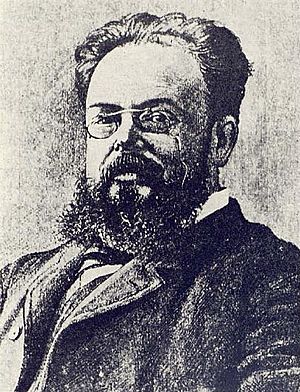Rafael Farga i Pellicer facts for kids
Quick facts for kids
Rafael Farga i Pellicer
|
|
|---|---|

Rafael Farga i Pellicer c. 1880
|
|
| Born | 12 August 1844 |
| Died | 14 August 1890 (aged 46) Barcelona, Spain
|
| Nationality | Catalan |
| Other names | Justo Pastor de Pellico |
| Citizenship | Kingdom of Spain (1844–1873) Spanish Republic (1873–1874) (1874–1890) |
| Occupation | Typesetter |
| Years active | 1868–1888 |
| Organization | FRE-AIT (1870–1881) FRTE (1881–1888) |
| Movement | Anarchism, Collectivism |
Rafael Farga i Pellicer (born August 12, 1844 – died August 12, 1890) was a very important person from Catalonia, a region in Spain. He was known by another name, "Justo Pastor de Pellico." Rafael was a talented typesetter, which means he arranged letters and words for printing books and newspapers. He was also a political cartoonist, a painter, and a journalist. Most importantly, he was a syndicalist and an anarchist who worked hard to improve the lives of working people.
Contents
Rafael Farga's Early Life and Work
Rafael Farga was born in Barcelona, Spain. He grew up during a time when many people in Spain were struggling. He became a typesetter, a skilled job that was very important before computers. Typesetters carefully placed metal letters to create pages for printing.
This job helped him understand the challenges faced by workers. He saw how long hours and low pay affected families. This made him want to help create a fairer society for everyone.
Fighting for Workers' Rights
Rafael Farga was a strong believer in anarchism. This is a political idea that suggests people can live together peacefully without needing a government to control them. Anarchists believe in freedom and equal rights for all.
He was also a collectivist. This means he thought that resources and production should be owned and managed by the community. He believed that everyone should work together for the good of all.
Farga was very active in workers' organizations. He joined the Spanish Regional Federation of the IWA (FRE-AIT) in 1870. This group was part of a larger international movement to unite workers. He later joined the Federation of Workers of the Spanish Region (FRTE) in 1881. These groups aimed to improve working conditions and fight for workers' rights.
A Voice for Change
Rafael Farga used his skills as a journalist and cartoonist to share his ideas. He wrote articles and drew pictures that showed the problems in society. He wanted people to think about how things could be better.
He believed that education was key to a better future. He also thought that workers should have more control over their lives and their jobs. His writings and drawings helped to spread these important messages.
Rafael Farga's Important Writings
Rafael Farga wrote and contributed to several important works. These writings shared his ideas about society and how to make it fairer. He often wrote about the importance of freedom and equality.
- He helped write a history book called Garibaldi. Historia Liberal del Siglo XIX. This book looked at important ideas and people from the 19th century.
- He also wrote about the art of typesetting in Prolegómenos de la composición tipográfica. This showed his deep knowledge of his craft.
- After he passed away, some of his writings were published with a biography of Mikhail Bakunin, another famous anarchist thinker. This included Bakunin's ideas on "The School of the Future."
Rafael Farga spent his life working for a better world. He used his talents to speak up for those who had no voice. His ideas helped shape the workers' movements in Spain during his time.
See also
 In Spanish: Rafael Farga para niños
In Spanish: Rafael Farga para niños 
- International Anarchist Congresses
- Anarchism in Spain

